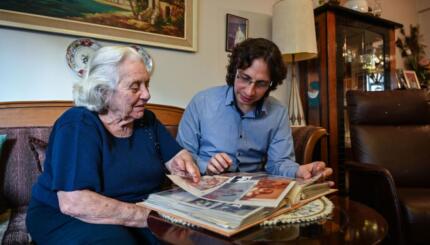Reprinted with permission from JBooks.com.
By all the laws of literary logic, Steve Stern’s psychic excavations of old-time Memphis ought not to exist. But exist they do–and in ways that his growing number of readers recognize like a thumbprint. Why so? Because Stern gives magical realism new possibilities, ones that, by crafty increments and sentences to die for, transform the ordinary into the miraculous.
Stern is equally comfortable in a wide variety of genres–the novel, novella, short story, and children’s fiction–but he operates at his best within the canvas of a short story. In roughly the same way that figures in a Chagall painting float over shtetl rooftops, Stern’s characters suggest a poignant immediacy that depends, in part, on brevity. The result is stories in which virtually anything can happen–and usually does.
Stern cut his imaginative teeth as a folklorist (in 1983, he served as director of the Center for Southern Folklore’s Ethnic Heritage Program), and the Yiddish oral histories he transcribed as part of his work began to reassemble themselves in his mind. Thus it was that the Pinch District (Memphis’ Old Jewish section) "rose up," in Stern’s words, "like the Lost Continent of Atlantis for me and began to look like a home for my stories." The result is at once a haunting memory and an intimation of the entirely new–for Stern so blends the surface detail of what was with infusions of the fantastic that it is often difficult to know where accuracy ends and magical realism begins. As one character puts it: "It’s like…being awake in your dreams."
With your help, My Jewish Learning can provide endless opportunities for learning, connection and discovery.
The Wedding Jester brings nine of Stern’s most accomplished stories between paperback covers. Four are set in the Pinch, with the others divided among the Old Country, Manhattan, and the Catskills. In the collection’s title story, Saul Bozoff, a 53-year-old writer who had acquired a modest reputation–and an academic job–for a collection of stories about "the Pinch," accompanies his mother to a wedding at a decrepit Catskill hotel.
On the face of it, this looks like a literary equivalent of been-there, done-that, but Stern has some very funny Yiddish ghosts up his sleeve. If Bozoff "populated his tales with every species of folklore, every manner of fanciful event," only to discover, painfully, that the spell that made his fiction possible has been broken, the same thing cannot be said of Stern–however many biographical echoes resonate between them. Indeed, one need only offer up "The Wedding Jester," the side-splitting tale of a bride invaded by the dybbuk of a long-dead Catskill comedian, as Exhibit A. In another story, "Bruno’s Metamorphosis," yet another Stern character suffers through the pangs of writer’s block: The happy news of Stern’s latest collection is that he, thank heaven, continues to write, and at the top of his form in the bargain.
With the notable exception of "A String Around the Moon: A Children’s Story," most of the shorter short stories pall when compared with longer, more complicated ones such as "Romance, or Yiddish Twilight." And in the case of "The Sin of Elijah," a tale of voyeurism and marital passion, Stern may well have penned the sexiest Jewish tale since "The Song of Songs."
There are many reasons to savor Stern’s stories–they remind us of a world and folkloric traditions long faded from memory, as well as of the imagination’s wilder side–but perhaps the most telling of all is the sheer pleasure they provide. All this will seem obvious to those who have read earlier Stern collections, but for those who have not, it is time they learn for themselves just how many characters can be crowded into a most unlikely ghetto. My favorites–and I am hardly alone–are "Lazar Malkin Enters Heaven" (from Stern’s prize-winning collection of the same name) and "The Tale of a Kite," probably his most anthologized story.
That The Wedding Jester begins with a mystical rabbi tethered to the earth, like a kite, and ends with a tale of how the moon is held captive in a room by way of a string is surely no accident–just as Stern’s crystal-clear prose teases us out of thought and resonates long after the last (invariably poetic) paragraphs seem over.


